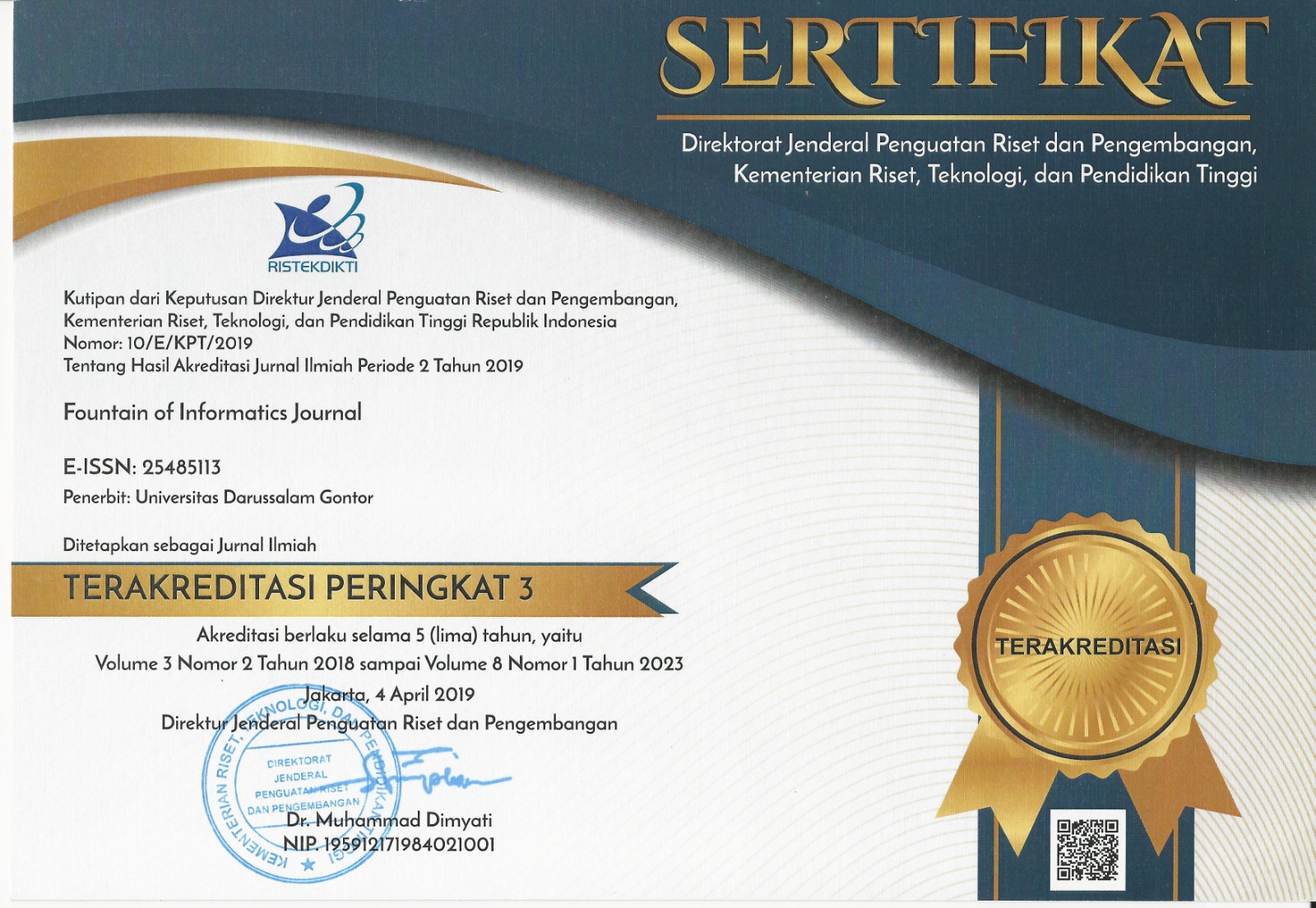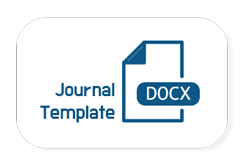Implementasi Teknik Seleksi Fitur Pada Klasifikasi Malware Android Menggunakan Support Vector Machine
DOI:
https://doi.org/10.21111/fij.v3i1.1875Keywords:
Classification Android Malware, Feature Selection, SVM and Multi Class SVM one against oneAbstract
Android Malware has grown significantly along with the advance of the times and the increasing variety of technique in the development of Android. Machine Learning technique is a method that now we can use in the modeling the pattern of a static and dynamic feature of Android Malware. In the level of accuracy of the Malware type classification, the researcher connect between the application feature with the feature required by each type of Malware category. The category of malware used is a type of Malware that many circulating today, to classify the type of Malware in this study used Support Vector Machine (SVM). The SVM type will be used is class SVM one against one using the RBF Kernel. The feature will be used in this classification are the Permission and Broadcast Receiver. To improve the accuracy of the classification result in this study used Feature Selection method. Selection of feature used is Correlation-based Feature Selection (CFS), Gain Ratio (GR) and Chi-Square (CHI). A result from Feature Selection will be evaluated together with result that not use Feature Selection. Accuracy Classification Feature Selection CFS result accuracy of 90.83%, GR and CHI of 91.25% and data that not use Feature Selection of 91.67%. The result of testing indicates that permission and broadcast receiver can be used in classifying type of Malware, but the Feature Selection method that used have accuracy is a little below the data that are not using Feature Selection.References
N. Yadav, A. Sharma, and A. Doegar, “A Survey on Android Malware Detection,†vol. 7, no. 12, pp. 47–53, 2016.
www.appbrain.com, “Number of Android applications,†2017. [Online]. Available: https://www.appbrain.com/stats/number-of-android-apps/. . [Accessed: 25-Jan-2017].
J. Rivera and R. van der Meulen, “Gartner Says Annual Smartphone Sales Surpassed Sales of Feature Phones for the First Time in 2013,†Gartner Newsroom, 2014. [Online]. Available: http://www.gartner.com/newsroom/id/2665715.
C. La and P. Myo, “Manifest Files Classification of,†vol. 2, no. 2, pp. 119–133, 2014.
V. Wahanggara and Y. Prayudi, “Sistem Deteksi Malicious Software Berbasis System Call untuk Klasifikasi Barang Bukti Digital Menggunakan Metode Support Vector Machine,†SENTRA (Seminar Nas. Teknol. dan Rekayasa), no. July, pp. 1–8, 2015.
S. P. Chorghe and N. Shekokar, “An Innovative Technique to Detect Malicious Applications in Android,†Int. J. Sci. Res., vol. 4, no. 12, pp. 2013–2016, 2015.
N. Peiravian and X. Zhu, “Machine learning for Android malware detection using permission and API calls,†in Proceedings - International Conference on Tools with Artificial Intelligence, ICTAI, 2013, pp. 300–305.
S. Y. Yerima, S. Sezer, and G. McWilliams, “Analysis of Bayesian Classification-based Approaches for Android Malware Detection,†Inf. Secur. IET, vol. 8, no. July 2013, pp. 25–36, 2014.
S. Yerima and G. Mcwilliams, “Machine Learning based malware detection for Android using static analysis,†no. January, 2012.
E. Rasywir and A. Purwarianti, “Eksperimen pada Sistem Klasifikasi Berita Hoax Berbahasa Indonesia Berbasis Pembelajaran Mesin,†J. Cybermatika, vol. 3, no. 2, pp. 1–8, 2015.
T. Djatna and Y. Morimoto, “Pembandingan Stabilitas Algoritma Seleksi Fitur menggunakan Transformasi Ranking Normal,†J. Ilmu Komput., vol. 6, no. 2, pp. 1–6, 2008.
H. Yu, X. Huang, X. Hu, and H. Cai, “A Comparative Study on Data Mining Algorithms for Individual Credit Risk Evaluation,†in 2010 International Conference on Management of e-Commerce and e-Government, 2010, pp. 35–38.
D. Zhang, H. Huang, Q. Chen, and Y. Jiang, “A comparison study of credit scoring models,†in Proceedings - Third International Conference on Natural Computation, ICNC 2007, 2007, vol. 1, pp. 15–18.
Downloads
Submitted
Accepted
Published
Issue
Section
License
Please find the rights and licenses in the Fountain of Informatics Journal (FIJ). By submitting the article/manuscript of the article, the author(s) agree with this policy. No specific document sign-off is required.
1. License
The non-commercial use of the article will be governed by the Creative Commons Attribution license as currently displayed on Creative Commons Attribution-NonCommercial-ShareAlike 4.0 International License.Â
2. Author(s)' Warranties
The author warrants that the article is original, written by the stated author(s), has not been published before, contains no unlawful statements, does not infringe the rights of others, is subject to copyright that is vested exclusively in the author, and free of any third party rights, and that any necessary written permissions to quote from other sources have been obtained by the author(s).
3. User/Public Rights
FIJ's spirit is to disseminate articles published are as free as possible. Under the Creative Commons license, FIJ permits users to copy, distribute, display, and perform the work for non-commercial purposes only. Users will also need to attribute authors and FIJ on distributing works in the journal and other media of publications. Unless otherwise stated, the authors are public entities as soon as their articles got published.Â
4. Rights of Authors
Authors retain all their rights to the published works, such as (but not limited to) the following rights;
- Copyright and other proprietary rights relating to the article, such as patent rights,
- The right to use the substance of the article in own future works, including lectures and books,
- The right to reproduce the article for own purposes,
- The right to self-archive the article (please read out deposit policy),
- The right to enter into separate, additional contractual arrangements for the non-exclusive distribution of the article's published version (e.g., post it to an institutional repository or publish it in a book), with an acknowledgment of its initial publication in this journal (Jurnal Optimasi Sistem Industri).
5. Co-Authorship
If the article was jointly prepared by more than one author, any authors submitting the manuscript warrants that he/she has been authorized by all co-authors to be agreed on this copyright and license notice (agreement) on their behalf, and agrees to inform his/her co-authors of the terms of this policy. FIJ will not be held liable for anything that may arise due to the author(s) internal dispute. FIJ will only communicate with the corresponding author.
6. Royalties
Being an open accessed journal and disseminating articles for free under the Creative Commons license term mentioned, author(s) aware that FIJ entitles the author(s) to no royalties or other fees.Â
7. Miscellaneous
FIJ will publish the article (or have it published) in the journal if the article’s editorial process is successfully completed. FIJ's editors may modify the article to a style of punctuation, spelling, capitalization, referencing, and usage that deems appropriate. The author acknowledges that the article may be published so that it will be publicly accessible and such access will be free of charge for the readers as mentioned in point 3.










